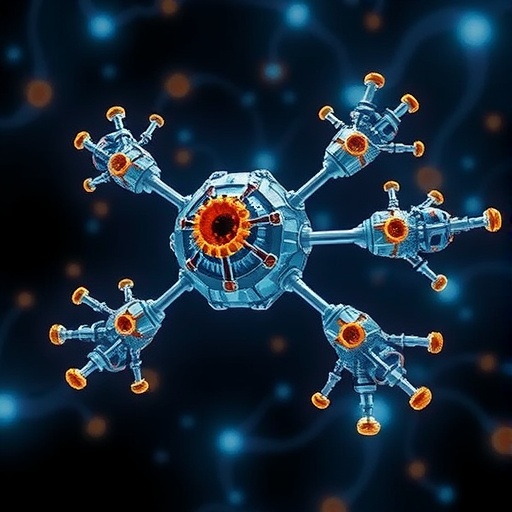In an extraordinary leap forward in materials science and molecular engineering, researchers from Japan have pioneered a revolutionary conceptual framework known as supramolecular robotics. Documented in the latest issue of Accounts of Materials Research, this emerging field transcends traditional boundaries by harnessing the intricate dance of noncovalent molecular interactions—such as hydrophobic forces, hydrogen bonding, and electrostatics—to create soft, adaptive materials capable of autonomous motion, transformation, and self-assembly. Unlike conventional synthetic materials that are constrained to single-mode responses, these systems mimic the sophisticated, integrated behaviors characteristic of living organisms, opening new horizons for intelligent matter.
At the heart of supramolecular robotics lies the principle that molecules themselves can serve as dynamic building blocks, organizing and reorganizing in response to subtle chemical stimuli. This fluency in molecular choreography grants the materials an unprecedented degree of programmability, enabling them to execute complex motions and structural changes reminiscent of biological processes like motility and tissue formation. The research team, led by Associate Professor Taisuke Banno at Keio University, delineates a roadmap to engineering soft materials imbued with life-like functionalities without relying on rigid, predesigned architectures.
Motility—the capability for autonomous movement—emerges as a foundational attribute within this framework. Employing micron-sized oil droplets suspended in aqueous environments, the researchers exploited the Marangoni effect, whereby gradients in interfacial tension induce surface flows that propel droplets spontaneously. These chemically powered droplets can navigate their surroundings directionally or collectively organize into swarming patterns evocative of microbial colonies. This ability to translate microscale physicochemical gradients into purposeful locomotion represents a potent strategy for fabricating microscale soft robots with applications ranging from precision drug delivery to environmental sensing.
Complementing motility is the dynamic phenomenon of phase transitions, where supramolecular assemblies reversibly switch between distinct structural states such as micelles, vesicles, and gels. Triggered by external stimuli—including variations in pH or light exposure—these transformations are integral to achieving adaptive functionality within the materials. They parallel biological responses observed in natural systems, enabling materials to heal, remodel, or activate therapeutics in a controlled manner under nonequilibrium conditions. This responsive phase behavior anchors the materials’ versatility and adaptability in fluctuating environments.
The assembly of individual protocell-like vesicles into larger, tissue-like structures—termed prototissue formation—marks another remarkable achievement within supramolecular robotics. Guided by finely tuned non-covalent interactions, these protocells organize into coherent multicompartmental entities exhibiting collective behaviors and communication across boundaries. Through reversible interactions, these macroscopic structures can respond adaptively, mimicking cellular communication and repair mechanisms. Such self-organized prototissues herald a new paradigm in constructing soft materials that integrate emergent functionalities from the bottom up.
The research underlines the vital role of chemical signal processing in enabling these adaptive systems. By weaving molecular recognition with dynamic assembly and disassembly, the materials operate as autonomous entities capable of processing environmental information and executing coordinated responses. This integrated responsiveness sets supramolecular robotics apart from prior bioinspired materials that typically rely on isolated or static functionalities. The approach elevates soft materials from passive responders to active agents resembling living matter in complexity.
One of the most visually compelling demonstrations from the study showcases the ability to “write” with molecular assemblies by shaping vesicle-based prototissue fibers into letter-shaped patterns on the microscale. This molecular handwriting underscores the programmable and processable nature of these materials, opening prospects for microscopic patterning and encoding information through soft matter architectures. Such sophisticated control over material form and function posits intriguing possibilities for information storage, tissue engineering, and responsive surfaces.
Looking beyond the laboratory bench, the implications of supramolecular robotics are vast and transformative. In biomedicine, these adaptive soft materials could revolutionize targeted drug delivery by navigating complex biological milieus, releasing therapeutic payloads precisely in response to physiological cues. Environmental science stands to benefit from microscale autonomous systems capable of detecting and neutralizing pollutants with minimal external oversight. Additionally, in robotics, the incorporation of molecularly driven motion and self-regulation portends the creation of next-generation soft robots unbounded by rigid mechanical components.
The interdisciplinary collaboration vital to this advancement drew on the expertise of Dr. Tomoya Kojima and Ph.D. candidate Shoi Sasaki, reflecting the synthesis of chemistry, materials engineering, and systems design. Their focus on soft matter platforms like self-propelled droplets and coacervates highlights the diversity of molecular constructs harnessed within supramolecular robotics. This synergy between fundamental chemical interactions and emergent system-level behaviors defines the frontier of intelligent material research.
Central to these developments is the recognition that nonequilibrium and nonlinear phenomena govern the behavior of supramolecular systems, enabling them to sustain dynamic states far from thermodynamic equilibrium. This intrinsic energy dissipation and molecular flux mimic biological homeostasis and adaptability, underscoring the importance of supramolecular chemistry in constructing functional materials. Future research will likely deepen understanding of these principles to refine control over motion, assembly, and communication.
The researchers envision a future where molecular strategies foster autonomous materials that not only sense and respond but also evolve functionalities over time. Self-regulating soft materials could advance beyond predefined roles, adapting in unpredictable environments without external programming. This vision bridges the gap from molecular recognition to machine-like intelligence embedded in soft matter, challenging traditional paradigms in robotics and materials science.
Ultimately, the pioneering concept of supramolecular robotics redefines our relationship with materials—from static substrates to dynamic entities exhibiting life-like versatility. This emerging field may spark novel therapeutic modalities, environmental technologies, and robotic platforms that embody the fluid intelligence inherent in biological systems. As research progresses, the fusion of molecular chemistry with robotic principles promises to unlock a new era of adaptive, intelligent soft materials, pushing boundaries at the intersection of chemistry, biology, and engineering.
Subject of Research: Not applicable
Article Title: Toward Supramolecular Robotics: Molecular Strategies for Adaptive Soft Materials
News Publication Date: 7-Aug-2025
References: DOI: 10.1021/accountsmr.5c00070
Image Credits: Keio University, Japan
Keywords
Robotics, Applied sciences and engineering, Artificial intelligence, Supramolecular chemistry, Physical sciences




